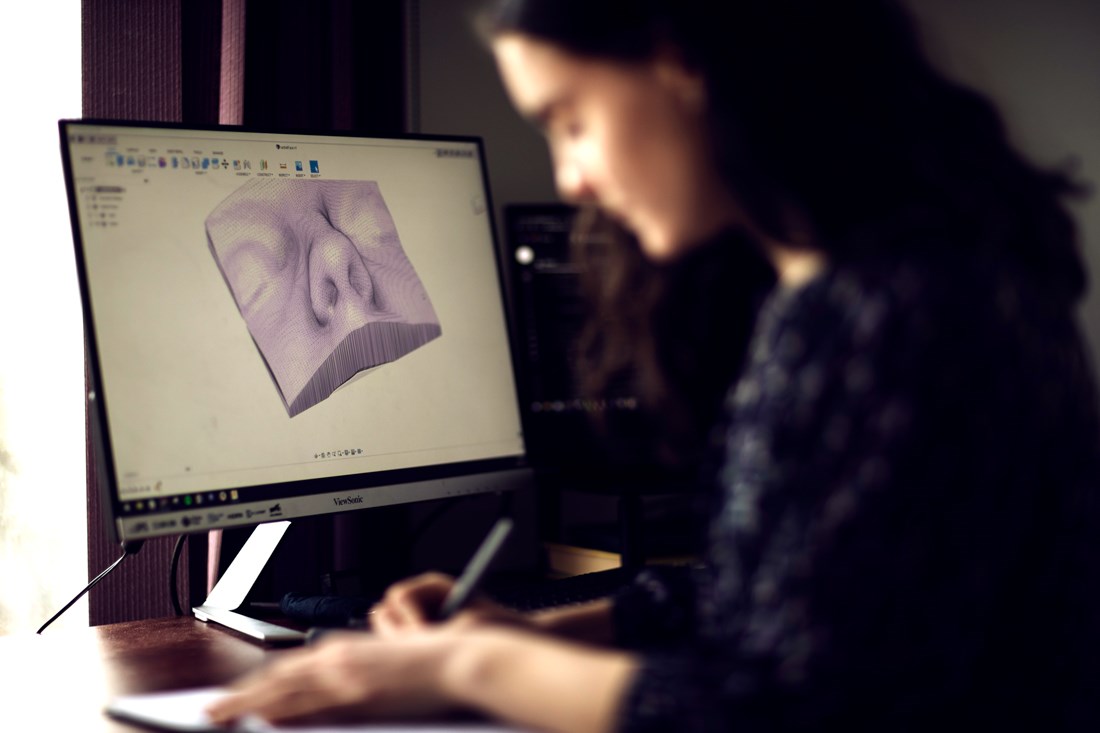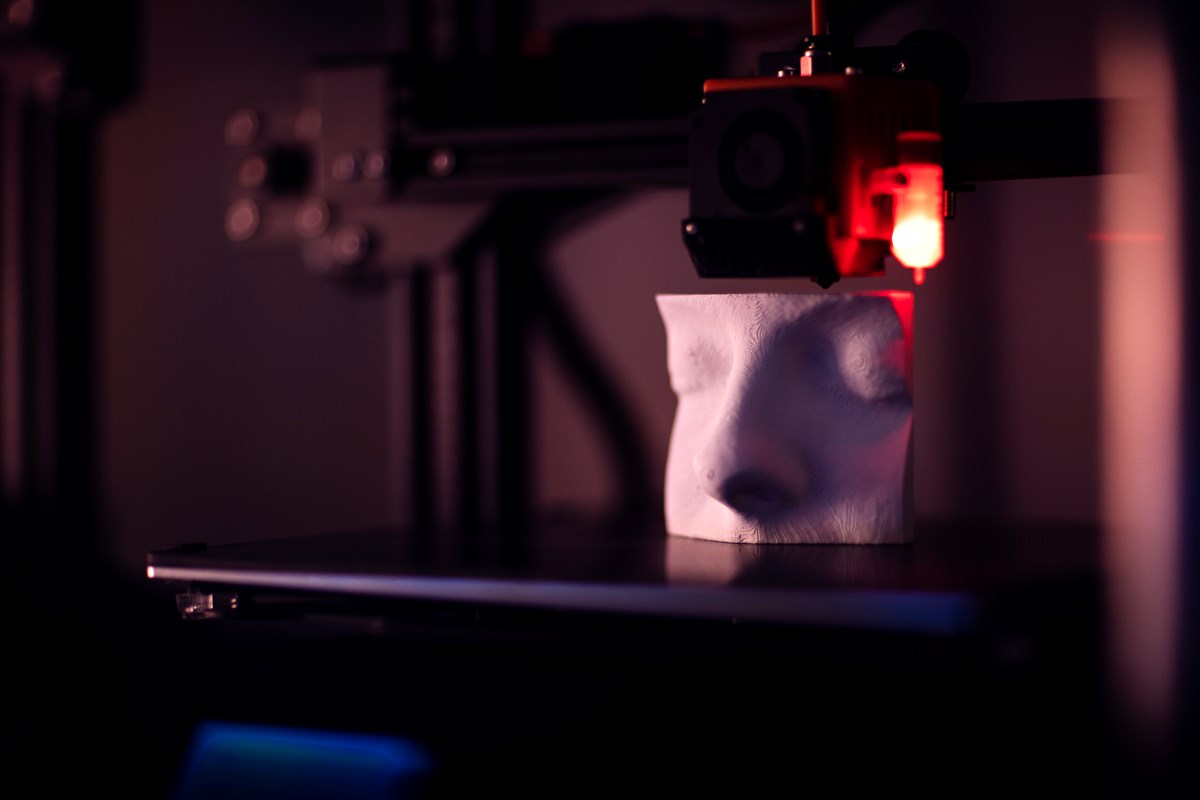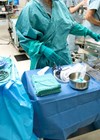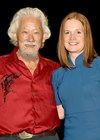As we try to avoid disposing of equipment that is still functional, we are challenged by company policies that make equipment ‘obsolete’ and no longer supported for repairs. One innovative solution is provided by 3D printing parts that are needed to keep equipment functional.


A computer 3D model of the face and the 3D-printed version of that. Images courtesy of PolyUnity Tech Inc.
The intersection of sustainability and 3D printing in audiology and ENT warrants detailed exploration as it may represent a viable pathway to the triple bottom line of economic, social, and environmental sustainability [1].
Audiology and ENT specialists are increasingly recognising the importance of more sustainable practices in their field, and 3D-printing technology has the potential to integrate seamlessly into current workflows, improve patient experience, and reduce waste all while meeting ever tighter financial constraints. As a sector, additive manufacturing is expected to grow to a $8.9 billion industry in the next five years, with $1.9 billion (21%) to be spent on medical applications including ENT and audiology [2].
Reducing material waste
The healthcare sector, at large, generates substantial environmental impact, contributing significantly to land, water, and air pollution and global greenhouse gas (GHG) emissions. In the UK, the National Health Service (NHS) exhibits a carbon footprint larger than certain European countries, such as Slovenia [3]. Similarly, if the US healthcare sector were a nation, it would rank as the world’s 13th‑largest GHG emitter, surpassing the entire UK’s emissions from all sectors [4]. This sizable carbon footprint primarily stems from clinical factors like pharmaceutical production, medical equipment, and clinical-related travel. Recently, public awareness regarding climate change’s health risks has made GHG reduction a central theme in healthcare sustainability discussions [5].
"3D-printing technology has the potential to integrate seamlessly into current workflows, improve patient experience, and reduce waste all while meeting ever tighter financial constraints"
One of the most significant advantages of 3D printing in audiology and ENT is the reduction of material waste. Traditional manufacturing methods often result in a significant amount of waste, which can be costly and harmful to the environment. 3D printing, on the other hand, uses an additive process that creates objects layer by layer, reducing waste and minimising the need for raw materials as well as potentially eliminating shipping and transportation costs if devices are customised on site [2,6,7].
According to a study published in the Journal of Cleaner Production, 3D printing can reduce greenhouse gas emissions significantly and can also reduce material usage by 30-80% during manufacture, compared to traditional manufacturing methods [8]. This significant reduction in environmental impact makes 3D printing an attractive option for audiology and ENT practitioners looking to adopt more sustainable practices. As of 2015, printers capable of producing entire hearing aids were commercially available and can be integrated into existing workflows [9].
Improved patient outcomes
In addition to reducing material waste, 3D printing could offer improved educational models by creating high fidelity simulators [10.11]. Customised hearing aids, earmoulds, and other devices can also be created using 3D-printing technology, providing patients with a more comfortable and personalised fit. This could lead to improved hearing outcomes and increased patient satisfaction. Furthermore, 3D printing allows for the creation of complex geometries and designs that would be difficult or impossible to produce using traditional manufacturing methods. This enables audiology and ENT specialists to create customised devices that are tailored to each patient’s unique needs, leading to better treatment outcomes.
"3D printing uses an additive process that creates objects layer by layer, reducing waste and minimising the need for raw materials"
Cost-effectiveness
A further advantage of 3D printing in audiology and ENT is its cost-effectiveness. Traditional manufacturing methods often involve high tooling costs and lengthy production times, which can result in expensive final products. 3D printing, on the other hand, eliminates the need for tooling and reduces production time, resulting in lower costs for both practitioners and patients. While there are many examples of cost savings in certain medical applications, like orthopaedic surgery and surgical planning, there is currently a lack of evidence for this in audiology – although several white papers report success in mass producing hearing aids [12,13]. However, one real-world example is CHEO (Children’s Hospital of Eastern Ontario) in Ottawa who has successfully undertaken a pilot of an in-house 3D printing in collaboration with PolyUnity Tech Inc, with support from OBIO’s Early Adopter Health Network (EAHN™). CHEO explored the potential of 3D printing to address supply chain issues by creating replacement parts, repairing equipment, and innovating new products. The evaluation engaged multiple departments across seven hospitals, resulting in over 200 innovations, 1281 products delivered, and significant cost savings. CHEO’s findings have led to a recommendation for other healthcare organisations to consider a fully managed 3D-printing solution [14]. While not exclusively ENT or audiology, this pilot’s findings reassure us that there is a place for 3D printing in healthcare.
"The evaluation engaged multiple departments across seven hospitals, resulting in over 200 innovations, 1281 products delivered, and significant cost savings"
Conclusion
3D printing may hold the potential to transform the landscape of audiology and ENT through onsite and/or personalised manufacturing of hearing instruments and medical devices, while simultaneously positively impacting sustainability by reducing waste. As we embrace a future where healthcare and environmental stewardship go hand in hand, it is evident that 3D printing will play an increasingly vital role.
References
1. Vergunst F, Berry HL, Rugkåsa J, et al. Applying the triple bottom line of sustainability to healthcare research—a feasibility study. Int J Qual Health Care 2020;32(1):48-53.
2. Aquino RP, Barile S, Grasso A, Saviano M. Envisioning smart and sustainable healthcare: 3D Printing technologies for personalized medication. Futures 2018;103:35-50.
3. Rogers S. Carbon emissions of Countries. The Guardian. 2012.
www.theguardian.com/environment/
datablog/2012/jun/21/world-carbon
-emissions-league-table-country#data
4. Eckelman MJ, Sherman J. Environmental Impacts of the U.S. Health Care System and Effects on Public Health. PLoS One 2016;11(6):e0157014.
5. Marmot M, Bell R. Fair society, healthy lives. Public Health 2012;126Suppl:S4-10.
6. Priyadarshini J, Singh RK, Mishra R, Dora M. Application of additive manufacturing for a sustainable healthcare sector: Mapping current research and establishing future research agenda. Technol Forecast Soc Change 2023;194(1):122686.
7. American Hospital Association. 3 Ways 3D Printing Is Revolutionizing Health Care. A pink 3D-printed prosthetic hand. 3 Ways 3D Printing Is Revolutionizing Health Care. Market Scan.
www.aha.org/aha-center-health-innovation-market
-scan/2022-06-07-3-ways-3d-printing
-revolutionizing-health-care
8. Jung S, Kara LB, Nie Z, et al. Is Additive Manufacturing an Environmentally and Economically Preferred Alternative for Mass Production? Environ Sci Technol. 2023;57(16):6373-86.
9. New Voxel8 3D Printer Slated to Print Custom Hearing Aids. The Hearing Review. 2015.
https://hearingreview.com/practice-building/
practice-management/continuing-education/
new-voxel8-3d-printer-can-custom-print-hearing-aids
10. Leung G, Pickett AT, Bartellas M, et al. Systematic review and meta-analysis of 3D-printing in otolaryngology education. Int J Pediatr Otorhinolaryngol 2022;155:111083.
11. Bartellas MP. Three-Dimensional Printing and Medical Education: A Narrative Review of the Literature. Univ of Ottawa J Med. 2016;6(1):38-43.
12. Wixted CM, Peterson JR, Kadakia RJ, Adams SB. Three-dimensional Printing in Orthopaedic Surgery: Current Applications and Future Developments. JAAOS Global Research & Reviews 2021;5(4):E200023011.
13. A success story. Inside Haus der Hörtechnik GmbH – Asiga.
www.asiga.com/a-success-story
-inside-haus-der-hortechnik-gmbh/
14. PolyUnity Tech Inc. secures contract for Agile Supply Chains and Additive-Manufacturing-as-a-Service (AMaaS). Pivotal Sources, SyndiGate Media Inc, 2022.
https://ocul-uo.primo.exlibrisgroup.com/
discovery/fulldisplay/cdi_proquest_wirefeeds
_2736493724/01OCUL_UO:UO_DEFAULT
All links last accessed October 2023.









